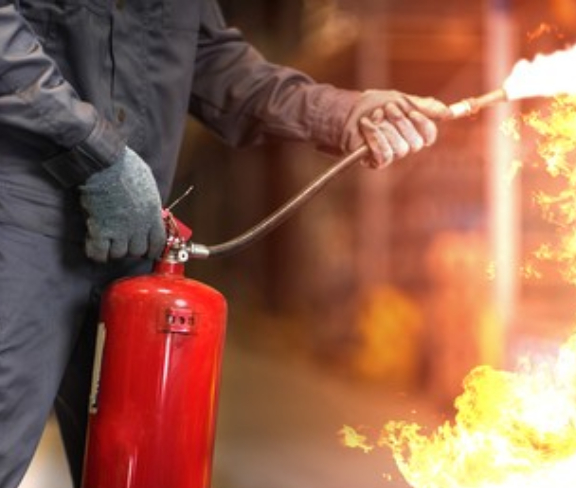Introduction
In today's world, fire safety is a critical concern for businesses and institutions. Ensuring that a building is fully compliant with fire safety regulations can prevent tragedies and save lives. The Safety Master stands at the forefront of this mission, offering meticulous fire safety audits that cover every aspect of fire prevention and safety. By understanding the nuances of a fire audit, including the creation and use of fire safety audit checklists and fire audit reports, organizations can ensure their environments are safe and compliant.
What is a Fire Safety Audit?
A fire safety audit is a way to check how safe a building or workplace is from fire. It looks at possible fire dangers in daily activities and suggests ways to make the place safer and reduce fire risks.

Fire Safety Audits by The Safety Master (TSM)
The Safety Master (TSM) provides fire safety audits for all types of buildings and industries, including hotels, hospitals, homes, schools, factories, chemical plants, power plants, FMCG companies, foundries, and mines.
Fires can cause serious harm to people and property. A fire safety audit is the best way to check fire safety standards in a building or workplace. It helps owners find areas that need improvement, create safety plans, prepare for emergencies, and conduct fire drills.
TSM’s expert team regularly carries out fire safety audits for high-rise buildings, hotels, banks, and businesses of all sizes. We follow important IS standards like the Automatic Fire Detection and Alarm System, Fire Extinguisher Selection and Maintenance Guidelines, National Building Code, Fire Safety Code for Buildings, and other safety rules. Our audits help identify fire hazards so they can be fixed and prevented.
Contact Us Now for More Details About Fire Audit
Our Address :- Unit No 221-450-451-452, SPL1/J, 2nd & 4th Floor, Sunsquare Plaza Complex, RIICO Chowk, Bhiwadi 301019, Rajasthan, India
TSM TheSafetyMaster Private Limited
(ISO 9001 & ISO 45001 Certified Company)
Contact Number
Contact E-Mail
Components of a Fire Safety Audit
- Inspection of Fire Safety Equipment: This includes checking fire alarms, extinguishers, and sprinkler systems.
- Review of Fire Safety Procedures: Ensuring that all evacuation plans and emergency procedures are up to date.
- Training and Drills: Verifying that staff are trained in fire safety and regular fire drills are conducted.
The Safety Master ensures that all these components are thoroughly reviewed during a fire audit.
Fire Safety Audit Checklist
A fire safety audit checklist is a crucial tool used during a fire audit. This checklist ensures that every aspect of fire safety is covered. The Safety Master uses a detailed fire safety audit checklist to systematically evaluate all fire safety measures. Some of the key items on the checklist include:
- Fire Detection Systems: Are all fire alarms functioning correctly?
- Fire Suppression Systems: Are fire extinguishers and sprinkler systems operational?
- Emergency Exits: Are all exits clearly marked and accessible?
- Fire Safety Signage: Is appropriate signage in place to guide occupants during an emergency?
Fire Audit Report
After completing a fire audit, The Safety Master provides a comprehensive fire audit report. This report details the findings of the audit, including any deficiencies and recommendations for improvement. The fire audit report serves as a critical document for ensuring ongoing fire safety and compliance.
Benefits of a Fire Safety Audit Checklist
Using a fire safety audit checklist offers several benefits:
- Thorough Evaluation: Ensures that no aspect of fire safety is overlooked.
- Compliance: Helps meet regulatory requirements.
- Risk Reduction: Identifies and mitigates potential fire hazards.
The Safety Master utilizes a detailed fire safety audit checklist to provide a thorough and effective fire audit.
Steps in Conducting a Fire Audit
Conducting a fire audit involves several steps:
- Preparation: Gathering necessary documents and previous audit reports.
- Inspection: Physical inspection of the premises using the fire safety audit checklist.
- Documentation: Recording findings and observations.
- Report Generation: Compiling the fire audit report.
- Follow-up: Addressing any issues identified in the fire audit report.
The Safety Master follows these steps meticulously to ensure a comprehensive fire audit.
Key Features of The Safety Master’s Fire Audit
The Safety Master offers several unique features in their fire audit services:
- Expertise: Highly trained professionals with extensive experience in fire safety.
- Comprehensive Checklists: Detailed fire safety audit checklists covering all aspects of fire safety.
- Thorough Reports: Detailed fire audit reports with actionable recommendations.
- Regular Follow-ups: Ensuring all identified issues are addressed promptly.
Common Findings in a Fire Audit
During a fire audit, common findings may include:
- Faulty Fire Alarms: Non-functional or poorly maintained fire alarms.
- Blocked Emergency Exits: Obstructed or locked exits.
- Inadequate Training: Staff not adequately trained in fire safety procedures.
- Insufficient Fire Equipment: Lack of or poorly maintained fire extinguishers and sprinklers.
The Safety Master identifies and addresses these common issues through their comprehensive fire audits.
Importance of Regular Fire Audits
Regular fire audits are crucial for maintaining fire safety. The Safety Master recommends conducting a fire safety audit at least once a year to ensure ongoing compliance and safety.
Fire Safety Audit Checklist: A Preventative Measure
Using a fire safety audit checklist is a preventative measure that helps identify potential fire hazards before they become serious issues. The Safety Master uses detailed checklists to ensure every aspect of fire safety is covered during a fire audit.
How to Prepare for a Fire Audit
Preparation for a fire audit involves several steps:
- Gather Documentation: Collect all relevant fire safety documents and previous fire audit reports.
- Review Procedures: Ensure all fire safety procedures are up to date.
- Conduct Internal Checks: Perform preliminary checks using a fire safety audit checklist.
The Safety Master provides guidance on how to effectively prepare for a fire audit.
Fire Audit Checklist for Different Industries
Different industries have unique fire safety requirements. The Safety Master tailors their fire safety audit checklists to meet the specific needs of various industries, including:
- Healthcare: Ensuring fire safety in hospitals and clinics.
- Education: Fire safety in schools and universities.
- Manufacturing: Addressing fire hazards in factories and warehouses.
The Role of Fire Audit Reports in Compliance
Fire audit reports play a vital role in ensuring compliance with fire safety regulations. The Safety Master provides detailed reports that help organizations meet all regulatory requirements.

